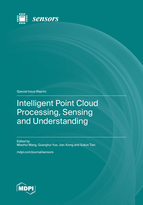Intelligent Point Cloud Processing, Sensing and Understanding
A special issue of Sensors (ISSN 1424-8220). This special issue belongs to the section "Sensing and Imaging".
Deadline for manuscript submissions: closed (20 February 2023) | Viewed by 34351
Special Issue Editors
Interests: computer vision and machine learning; image/video processing
Special Issues, Collections and Topics in MDPI journals
Interests: image processing; medical image analysis; computer vision
Special Issues, Collections and Topics in MDPI journals
Interests: video/image/point cloud processing; computer vision
Interests: medical image processing; deep learning; computer graphics and visualization
Special Issues, Collections and Topics in MDPI journals
Special Issue Information
Dear Colleagues,
Point clouds are deemed to be one of the foundational pillars in representing the 3D digital world, despite irregular topologies among discrete points. Recently, the advancements in sensor technologies that acquire point cloud data for flexible and scalable geometric representation have paved the way for the development of new ideas, methodologies, and solutions in countless remote sensing applications. State-of-the-art sensors are capable of capturing and describing objects in a scene by using dense point clouds from various platforms (satellites, aerial, UAVs, vehicle-borne, backpacks, handheld, and static terrestrial), perspectives (nadir, oblique, and side view), spectra (multispectral), and granularity (point density and completeness). Meanwhile, the ever-expanding application areas of point cloud processing have already covered not only conventional domains in geospatial analysis, but also include manufacturing, civil engineering, construction, transportation, ecology, forestry, mechanical engineering, and so on.
This Special Issue aims at contributions that focus on processing and utilizing point cloud data acquired from laser scanners and other 3D imaging systems. We are particularly interested in original papers that address innovative techniques for generating, handling, and analyzing point cloud data, challenges in dealing with point cloud data in emerging remote sensing applications, and developing new applications for point cloud data.
Dr. Miaohui Wang
Dr. Guanghui Yue
Dr. Jian Xiong
Dr. Sukun Tian
Guest Editors
Manuscript Submission Information
Manuscripts should be submitted online at www.mdpi.com by registering and logging in to this website. Once you are registered, click here to go to the submission form. Manuscripts can be submitted until the deadline. All submissions that pass pre-check are peer-reviewed. Accepted papers will be published continuously in the journal (as soon as accepted) and will be listed together on the special issue website. Research articles, review articles as well as short communications are invited. For planned papers, a title and short abstract (about 100 words) can be sent to the Editorial Office for announcement on this website.
Submitted manuscripts should not have been published previously, nor be under consideration for publication elsewhere (except conference proceedings papers). All manuscripts are thoroughly refereed through a single-blind peer-review process. A guide for authors and other relevant information for submission of manuscripts is available on the Instructions for Authors page. Sensors is an international peer-reviewed open access semimonthly journal published by MDPI.
Please visit the Instructions for Authors page before submitting a manuscript. The Article Processing Charge (APC) for publication in this open access journal is 2600 CHF (Swiss Francs). Submitted papers should be well formatted and use good English. Authors may use MDPI's English editing service prior to publication or during author revisions.
Keywords
- point cloud acquisition from laser scanners, stereo vision, panoramas, camera phone images, and oblique as well as satellite imagery
- deep learning for point cloud processing
- point cloud registration, segmentation, object detection, semantic labelling, compression, and quality assessment
- fusion of multimodal point clouds
- modeling of LiDAR/image-based point cloud processing
- industrial applications with large-scale point clouds
- high-performance computing for large-scale point clouds







